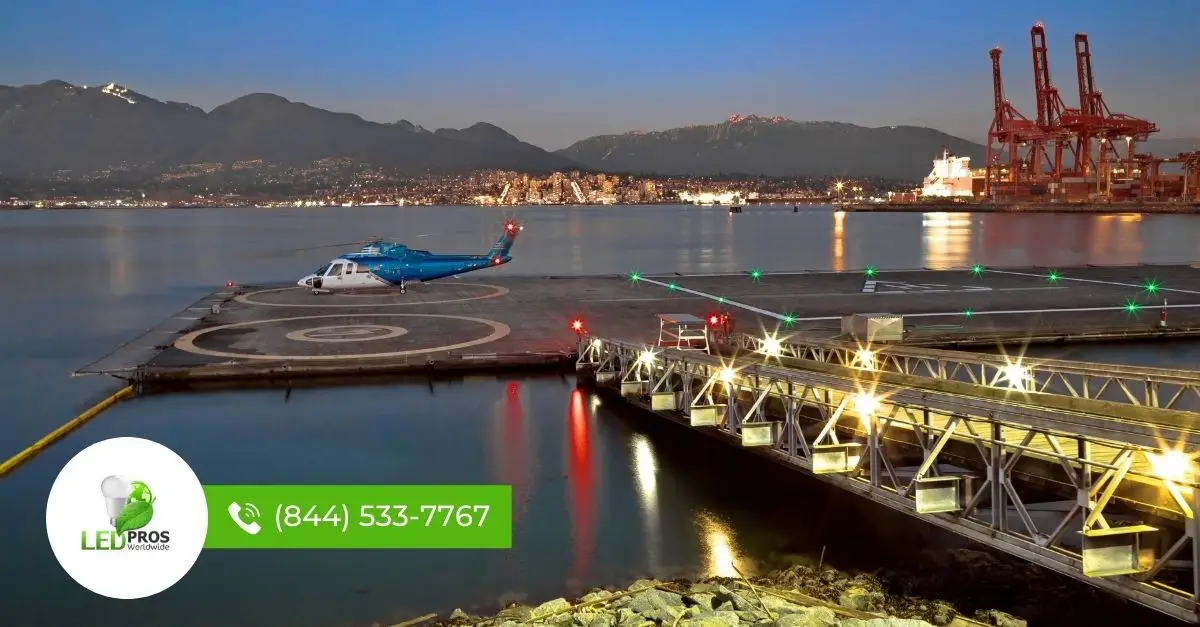When you think of airports, your mind likely conjures up images of massive terminals, long runways, and hulking passenger jets. But there’s another player in the aviation world that’s been quietly gaining altitude: heliports. These pint-sized airports, designed specifically for helicopters and other vertical lift aircraft, are becoming increasingly popular for a wide range of applications. And as the heliport market grows, so too does demand for specialized heliport lighting solutions. Explore the Benefits of Heliport Lights here
According to recent projections, the heliport lighting market is poised for steady growth over the next few years. Analysts forecast a healthy 4.31% compound annual growth rate (CAGR) between 2021 and 2025, translating to a $18.93 million increase in market value. While this growth isn’t based on passing fads, it’s firmly rooted in concrete drivers and market challenges. Let’s take a closer look at the factors propelling the heliport lighting market to new heights.
The Versatility of Heliports: A Key Growth Driver
One of the most significant factors fueling the expansion of the heliport lighting market is the increasingly diverse ways in which heliports are being utilized. No longer just the domain of emergency medical services and sightseeing tours, heliports are now serving a wide variety of functions:
– Helicopters: The bread and butter of heliports, helicopter usage continues to rise organically year-over-year.
– Drones: As drone technology advances and regulations evolve, more and more companies are exploring drone delivery services. These drones need secure, well-lit spaces for takeoffs and landings.
– Surveillance: Law enforcement and private security firms are increasingly turning to heliports as bases for aerial surveillance operations.
– Cargo Delivery: In addition to drones, some heliports are being used for more traditional cargo delivery via helicopter. This allows for rapid transport of time-sensitive goods.
As heliports take on these diverse roles, demand for high-quality, reliable lighting solutions is skyrocketing. Heliport operators need lighting that can support safe operations across a wide range of aircraft types and mission profiles. This is driving significant growth in the heliport lighting market.
Types of Helipad Lights
To ensure the safety of pilots, crew, passengers, and cargo, heliports require specialized lighting solutions:
1. Perimeter Lights: These lights define the edges and corners of the helipad, providing visual cues to guide approach and landing.
2. Flood Lights: Illuminating the helipad surface, flood lights help pilots gauge their height above the pad and maintain proper positioning.
3. Approach Path Indicators: These lights give pilots critical information about their angle of approach, helping them execute optimal descents.
4. Windsock Illumination: Heliports use lit windsocks to give pilots real-time information about wind conditions.
5. Obstruction Lights: Placed on nearby obstacles like trees or power lines, these lights warn pilots of potential hazards.
Advances in LED technology are making heliport lighting solutions more energy-efficient, cost-effective, and long-lasting than ever before. This is further contributing to market growth, as heliport operators look to modernize their lighting systems.
Drone Delivery: A Growing Factor
While the heliport lighting market isn’t solely reliant on the growth of drone delivery services, this emerging application is becoming an increasingly important demand driver. Companies exploring drone delivery need secure spaces for their drones to take off and land – makeshift launchpads on random rooftops simply won’t cut it from a safety and liability perspective.
As businesses seek out established, well-lit heliports to serve as drone hubs, they’re creating a new revenue stream for heliport operators and spurring investment in heliport lighting infrastructure. Industry insiders expect this trend to accelerate in the coming years as drone delivery moves from niche concept to mainstream service.
Military and Government Demand
The private sector isn’t the only one contributing to the growth of the heliport lighting market. Military and government organizations are also major heliports and lighting end users. In particular, the United States and United Kingdom are significantly ramping up their use of helicopters and drones for transport, combat, rescue, and surveillance missions.
This increased operational tempo translates directly to heightened demand for advanced heliport lighting solutions. From military bases to urban rooftops, state-of-the-art lighting is needed to keep military/government pilots and crews safe as they conduct a wide range of day/night operations. And as LED lighting becomes more affordable and widely available, more organizations are investing in upgrades and expansions.
 |
Frequently Asked Questions
Q: What types of aircraft use heliports?
A: Heliports support helicopters, vertical takeoff and landing (VTOL) aircraft, drones, and other specialty rotor aircraft.
Q: What’s driving growth in the heliport lighting market?
A: Key drivers include diverse heliport usage, drone delivery services, military/government demand, and LED lighting advances.
Q: How fast is the heliport lighting market expected to grow?
A: Analysts project a 4.31% CAGR for the heliport lighting market between 2021 and 2025.
Parting Words
The future looks bright for the heliport lighting market. With a projected 4.31% CAGR through 2025 and $18.93 million in growth on the horizon, this specialized sector of the aviation industry is primed for steady expansion. As heliports take on an ever-widening array of roles – from drone delivery hubs to military staging areas – and LED lighting solutions become more accessible and efficient, demand for advanced illumination will only continue to grow. For market players who can navigate the unique challenges of this niche, the skyward trajectory of the **heliport lighting market** represents a major opportunity. Expect to see the market continue gaining altitude in the years to come.
[gravityform id=”1″ title=”true” description=”true”]
